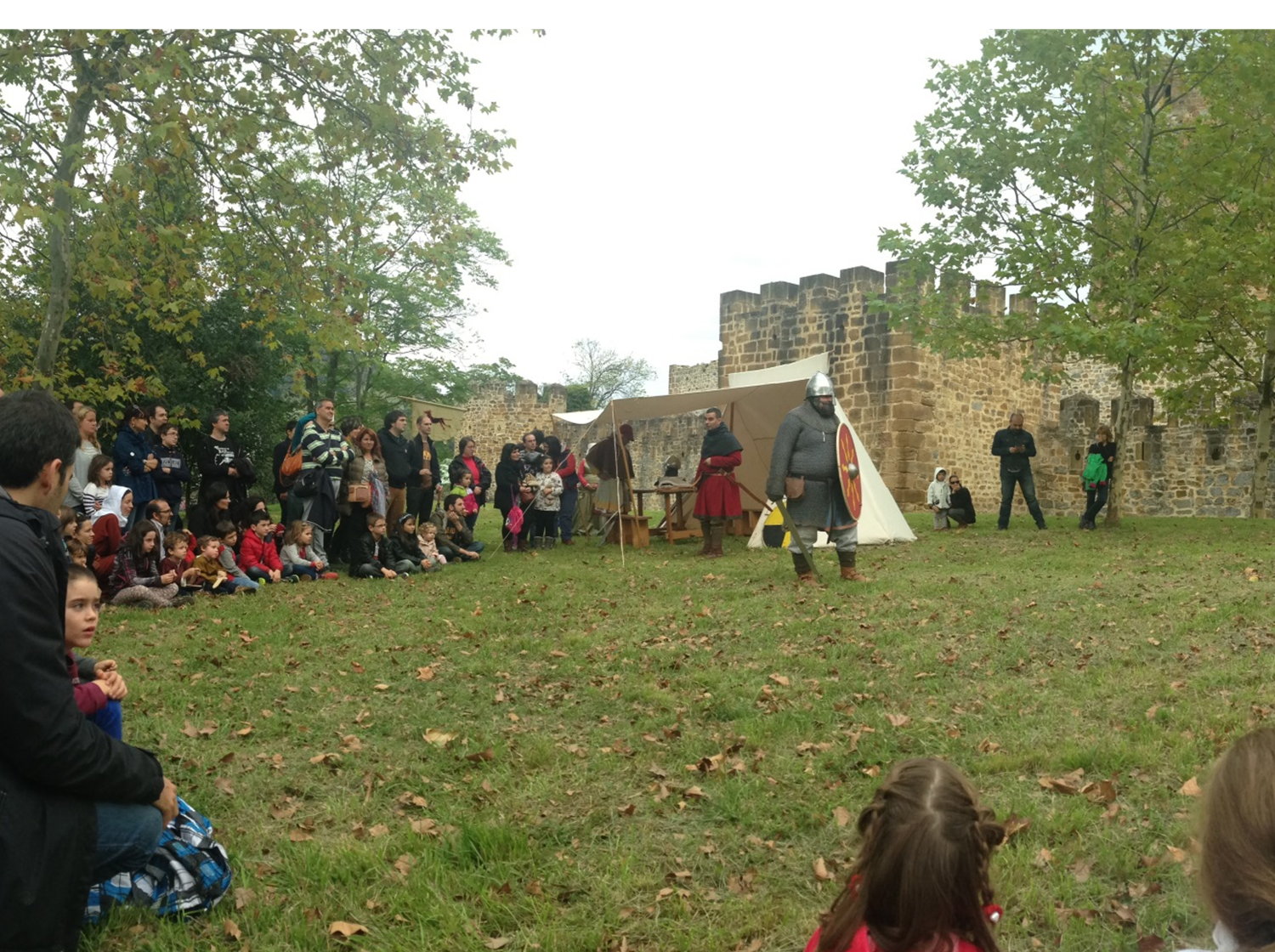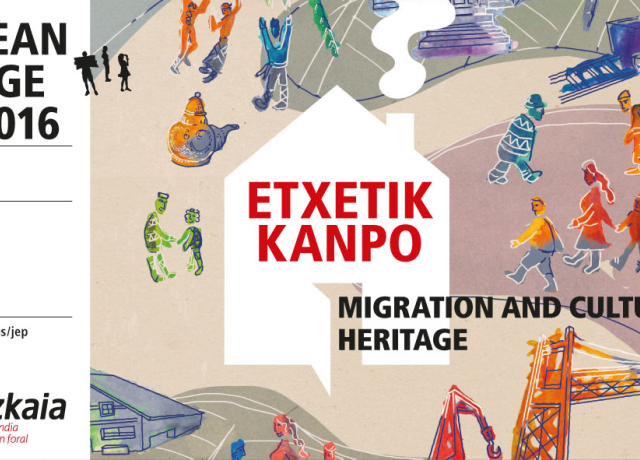The 16th edition of European Heritage Days in Bizkaia to Bridge national borders
The 16th edition of European Heritage Days in Bizkaia to Bridge national borders
- Under the slogan "Etxetik kanpo: migration and cultural heritage", the regional minister for Basque Language and Culture, Lorea Bilbao, presented the new edition of the programme, with almost 300 free activities disseminating cultural heritage for all audiences, which will take place throughout October.
- 65 town councils, 17 government entities and institutions, 17 museums and about 50 cultural associations will take part in organising this initiative which, as every year, is coordinated by the Provincial Council of Biscay.
On the morning of 19th September, the regional minister for Basque Language and Culture, Lorea Bilbao, presented the sixteenth edition of European Heritage Days under the slogan "Etxetik kanpo: migration and cultural heritage". The ceremony, which was held at the Fisherman’s Museum in Bermeo, was attended by a broad representation of more than a hundred participants who have made this edition possible.
European Heritage Days has, for the first time, included activities that bridge borders. Thus, Biscay and Iceland have joined forces to share a common past: relations between the Basques and the local population of the north west of Iceland in the 17th century. Furthermore, at this edition, greater prominence has been given to communities, as this year the Provincial Council has invited citizens who have been actively involved, not only by attending, but also through planning, defining and organising the programme of activities. By doing this, the Provincial Council is seeking to work in harmony with the new guidelines that the Council of Europe has provided for European states, which advocate a progressive democratisation of the concept of Cultural Heritage.
For the last 16 years, the Provincial Council has been committed to being involved in this European programme, which is promoted by the Council of Europe, in the task of spreading Biscayan cultural heritage as part of the common European heritage. It is an effort that is shared with the ensemble of town councils, public and private institutions and cultural and neighbourhood associations, who, once again, will be part of the European event.
Now well-established in the territory and coordinated since its inception by the Provincial Council, European Heritage Days in Biscay has become a valuable exponent of collaboration and involvement for social and institutional agents. European Heritage Days has become one of the main cultural events in the annual agenda of Biscay, due to the number of agents involved in the organisation, the quality and variety of the activities on offer and its ability to reach all corners of the region.
The cross-border nature of European Heritage Days

The Fisherman's Museum of the Provincial Council of Biscay is organising the exhibition "Basques in Iceland. Cod and whale fishing” for October, curated by Xabier Armendariz, which will reveal unknown details about the presence of Basque fishermen in northern lands. Their relationship with the Icelandic population, especially during the 17th and 18th centuries, from both a trading and human point of view. Encounters and conflicts, sometimes bloody, such as the massacre of Basques in 1615, which illustrate a common shared history, the memory and cultural influence of which has been kept alive to the present day in areas as diverse as language and traditional Icelandic clothing.
Magnús Rafnsson, from the Basque-Icelandic Association, will give a lecture on the interaction between the Basques and the locals of Strandasýsla in the north west of Iceland in the 17th century. As its title ("Basques in Iceland: reading between the lines") indicates, Rafnsson will try to shed light on the trade relationships between the locals and visitors, as well as matters related to the heart, arousing curiosity about the reaction of the young women who lived in an isolated community in the northern end of Iceland with the arrival one summer of 85 men, or how 60 sailors were received in local farms after a shipwreck.
For its part, the Academy of the Basque Language, Euskaltzaindia, will organise a lecture ("Euskararen aztarnak Islandian") by Gidor Bilbao as part of European Heritage Days, on pidgin Basque-Icelandic, a simplified language that was developed in the 17th and 18th centuries between the two communities. The language served as a vehicle for communication between locals and visitors with a glossary consisting of 745 Basque, Icelandic, French and English terms. The lecture will show and analyse the pidgin texts, trying to distinguish the Basque elements from other terms that come from other languages.
In addition, for the first time at the event, participants will have an opportunity to visit popularly known as "the English cemetery" in collaboration with the British Consulate, an enclave of 10,000 m2 owned by the British Crown in the municipality of Loiu. Created in 1926 in response to a need (for English people or other nationalities who did not profess the Catholic faith to be buried), it is the successor to the graveyard which has occupied the so-called "English compound" in Bilbao, next to the estuary, since the 17th century and evidence of the intense relationship between Great Britain and Biscay in recent centuries.
300 Cultural Activities Available for Free
The Provincial Council of Biscay, joining the initiative promoted by the Council of Europe, has coordinated this programme for the last 16 years. 63 town councils, 17 government entities and institutions, 17 museums and about 50 cultural associations were involved in this year’s festival. Between them, they have devised and programmed about 300 activities, from guided tours, lectures, exhibitions, demonstrations of crafts, fairs, gastronomy, film screenings, historical recreations, music, dance, sport, etc. to scientific lectures and university seminars focusing on the theme of diaspora, or population migration and movement from pre-history to the present day.
One of the novelties in terms of organising entities is the participation of institutions such as the University of the Basque Country, Unesco Etxea, the General Assembly of Biscay, the Historical Archive of the Basque Country, the Provincial Archive, the British Consulate and the Chinese Institute of Bilbao. Other entities continue their annual commitment to promoting culture, by offering new programming for this edition: the COAVN (Basque-Navarre Official College of Architects), Euskaltzaindia, the Historical Archive of Derio, the Provincial Library, various museums and interpretation centres in Biscay, as well as a number of town councils and municipal centres.
Heritage Communities, the new way of understanding the protection of cultural heritage
The Provincial Council of Biscay, as part of its scope of action, would like to be part of this new vision of cultural heritage promoted by the Council of Europe. The concept of Heritage Communities implies that the commitment to defend shared cultural heritage is a "project for society", in which all citizens not only have rights and responsibilities, but also a voice and decision in defining the actions to be considered a priority in the protection of heritage.
A reflection of this new way of understanding heritage is the role that various Biscayan associations and groups will play at this edition. They will carry out the work of defending, disseminating and promoting cultural heritage from different perspectives, regardless of origin, nationality, social group, etc. It is, therefore, a vision of heritage as an element of cohesion and coexistence. Thus, heritage is the common framework, while the focus is on people.
The activities organised by the neighbourhood associations (Uribarri, Otxarkoaga, Errekalde…), professional associations (Bilbao Old Town Traders’ Association) and cultural associations (Aunia, Basque Association of Industrial Heritage-AVPIOP, Arkikultura, Egizu…) are an example of the above. They are all examples of the involvement of citizens with more intimate heritage that they want to keep because it is part of their identity, their everyday life, their daily landscape...
.jpg)
In addition and in line with the theme chosen for this year, the festival was joined by immigrant groups, including both those who arrived during the industrial boom in Biscay (regional centres) and those who came in more recent times from other parts of the world (Gentes del Mundo [People of the World], Lipovan Russians, Mexico Lindo, Asociación Diáspora Saharaui…). Also, those entities that bring Biscay closer to faraway cultures, but with a presence in the Biscay of today, such as the programme organised by the Chinese Institute of Bilbao, Los Jardines de Kyoto, etc.
Furthermore, the event showcased the initiatives of individuals, as is the case with the private collection of Ramón Oleaga, who offers tours to learn more about his wide and interesting collection of maps.
More information at www.bizkaikoa.bizkaia.eus/jep

%20(26).JPG)
.JPG)